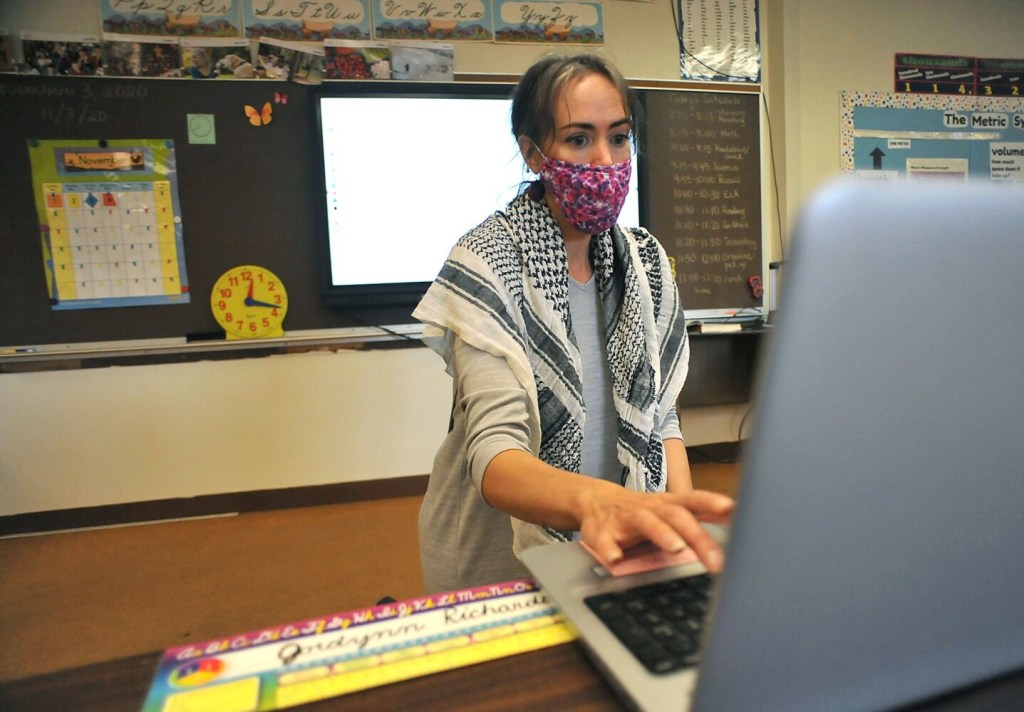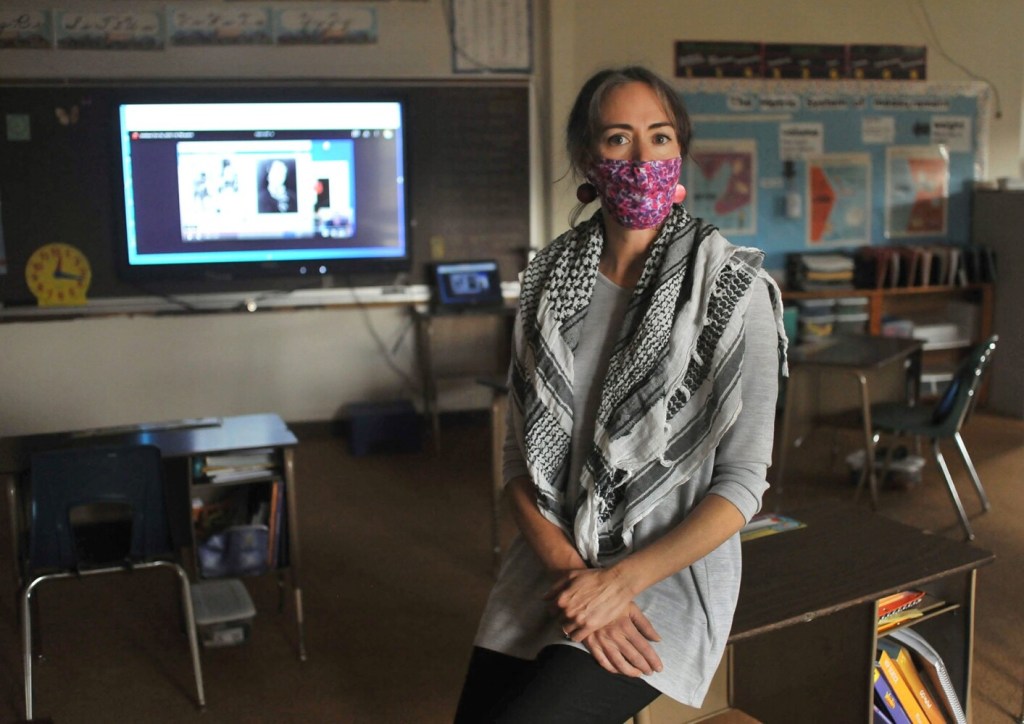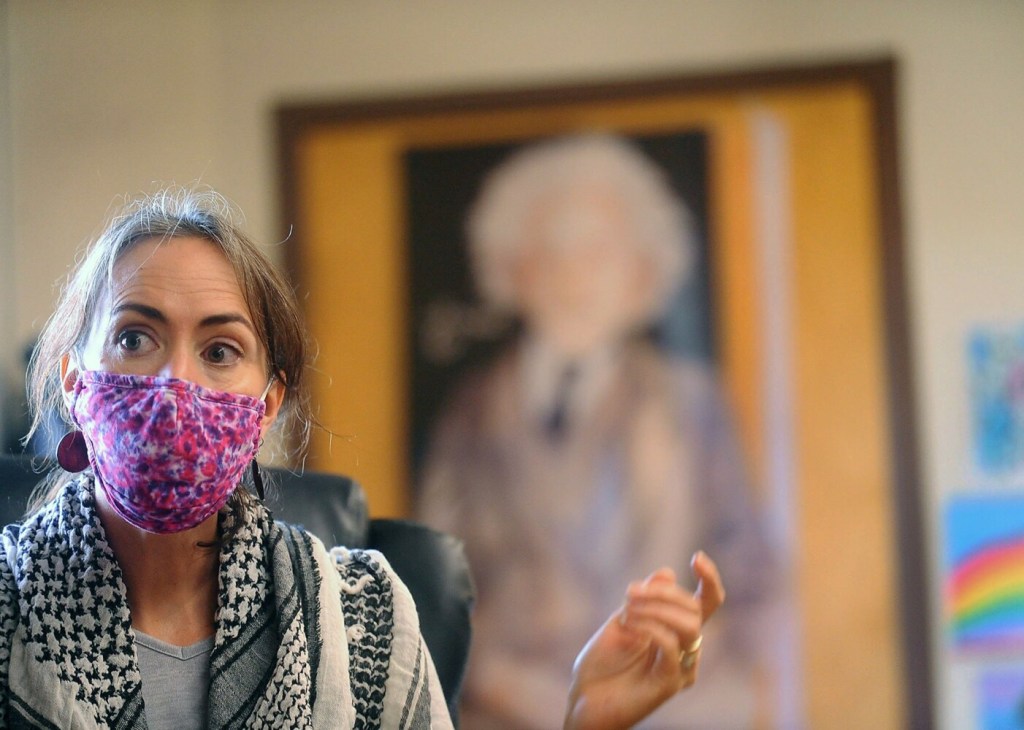SOLON — As cases of COVID-19 continue to spike in much of Maine, schools have had to shift, adapt and plan to provide the best educations for students.
Regional School Unit 74, which serves Anson, Embden, New Portland, North Anson and Solon, operates under four roofs: Garret Schenck School, Solon Elementary School, Carrabec Community School and Carrabec High School.
Somerset County was recently designated “yellow” under the Maine Department of Education’s reopening advisory system, meaning there is a moderate level of community risk and schools should consider precautions, such as limiting the number of people inside school buildings at the same time, suspending extracurricular or co-curricular activities and limiting interaction by splitting students into different cohorts.
Superintendent Mike Tracy said of the district’s 561 students, 125, or 22.3%, are learning remotely, and the numbers are divided almost evenly among the grade levels.
Tracy said some families shifted to remote learning after the county designation was changed, while some decided to return to in-person learning.
The district originally delayed the start of the academic year after a student tested positive for COVID-19. To date, this has been the only positive case within the district.
As of Friday, Somerset County has seen 262 cases of COVID-19, with 236 confirmed and 26 probable. Eight of those patients have died, 10 have been hospitalized and 138 have recovered, according to data.
Stacey McCluskey, a fifth-grade teacher at Solon Elementary School with 20 years in the classroom, said staff members are putting in more work than they did before the coronavirus because they understand the importance of strong educations for students.
“We are trying to replicate to the best of our ability everything we do in class for our remote learners,” McCluskey said. “That is why it is so labor-intensive. We have to include everything from the daily lessons to the morning meeting and our novel read-aloud.”
Many teachers have a classroom of students, and some who have opted to learn only remotely.
McCluskey recently gained her first remote student. Prior to being interviewed, McCluskey spoke with colleagues who have been working with remote learners since the beginning of the term.
“I am concerned for them. They are suffering,” McCluskey said. “They’re not making the time for self-care or exercise. They say that it’s really like doing two jobs.”
REMOTE PREPARATION
McCluskey’s classroom is set up for her eight students to learn in person. Different from previous years, each desk is about 3 feet from neighboring desks, and each student has his or her own bin of supplies to reduce the potential for spreading the virus.
There is also a designated window in the back corner for students to take mask breaks during the day.
Although the school days are shortened, McCluskey said, students still have designated times for recess. If they are outside on the playground and separated from one another, students may remove their masks.
“It’s challenging to stay separated when you’re outside playing. They do need a lot of reminders,” McCluskey said. “Some kids will elect to leave their mask on outside so they can play closer together. They’ll leave their mask on so they can swing side by side.”

Stacey McCluskey, a fifth-grade teacher at Solon Elementary School, make videos and creates content to use for remote learning for her eight students. She is shown at her classroom Monday, with the computer and large flat screen she uses to create lessons. Rich Abrahamson/Morning Sentinel Buy this Photo
McCluskey said many of her colleagues who have had remote students since the beginning of the school year are feeling overwhelmed, exhausted and burnt out at times.
“One of my friends is getting up at 4 in the morning to do schoolwork so that she can get some done before she gets her family off to school and work,” McCluskey said. “They’re staying until after 5 every night, and many of them did not take Indigenous Peoples Day off because they needed the day to catch up.”
McCluskey and Tracy emphasized in separate interviews that the COVID-19 pandemic is something educators statewide are facing.
“I am worried about the staff, too,” Tracy said. “The problem is that I have to be the guy with my foot on the gas pedal. We have to, in real time, make decisions to keep the balance. The staff is not ready to do more. We have to delicately train them.”
He added he operates under a chain-of-command leadership style, meaning he receives feedback mainly from principals at each building, who talk to their staffs. Additionally, he has met with each staff on a few occasions and plans to hold a Zoom videoconference call before the RSU 74 board of directors meeting scheduled for Dec. 2.
Although some in the community might feel the school staff could be doing more, Tracy said he cannot in good faith push his staff members to proceed if they are not ready, citing that many are working time and a half to meet the needs of their students.
Carrabec Schools are operating under the second phase of their reopening plan. Under this plan, students in kindergarten through fifth grade are in their classrooms Tuesday through Friday, and are dismissed at 12:30 p.m. Mondays are designated for teachers to prepare, connect with remote students and clean their classrooms.
Grades six through eight attend school Tuesday through Friday, with 50% of the student population studying under a hybrid model. These students are dismissed at 2:30 p.m. One cohort meets Tuesday and Thursday and the other Wednesday and Friday.
Grades nine through 12 attend school five days a week under a hybrid model, and are dismissed at 2:30 p.m. Like many districts statewide, educators in this district are utilizing SeeSaw and Google Classroom platforms for online learning.
SeeSaw is used for students from kindergarten through grade three. It provides a platform with icons and pictures, while Google Classroom is more text-oriented. All teachers have been trained on how to use these platforms and maintain an online classroom.
McCluskey said online lessons are also not synchronous because the district “is very protective of our students’ privacy.” Thus, teachers are often preparing remote lessons while also teaching classrooms full of students.
“A student has the right to privacy, and that includes knowing who has an individualized education plan,” she said. “We don’t talk about our students in public. To have their interactions broadcast for anyone could be violating their privacy.”
That is the main reason schools are not participating in synchronized learning, McCluskey said.
Tracy said the district has received about $1.3 million in CARES Act and COVID-19 relief grants. Unlike other districts, he said, RSU 74 officials have chosen not to hire additional staff members to assist with hybrid and remote learning because the district’s philosophy is to have staff members working with their students.
The majority of the funding has been used to hire a sanitizer for each building, nurse’s assistants at each building, an IT support staff member and bus monitors. In addition to the new hires, the district has also bought technology.
This, however, might change before the shift to the third phase of reopening, but those discussions have yet to be finalized. The discussion is expected to resume at the next RSU 74 board of directors meeting, scheduled for Dec. 2.
THE NEXT PHASE
The next phase in the district’s reopening proposal includes a plan to have students in kindergarten through fifth grade attend school full time, four days a week, giving them about two extra hours a week at school facilities.
Under phase three, grades six through eight will operate under a hybrid model, with the middle school matching what the high school is doing.
Because of the size of the schools and safety protocols, it is not possible to have all students at school facilities at once.
“We need more kids in here more of the time,” Tracy said, “but we can’t do it safely without going against the requirements.”
The major changes under this plan, Tracy said, is the additional day for middle schoolers and longer school days for those in kindergarten through grade five. Whether this begins at the beginning of 2021 or halfway through January has yet to be decided.

Stacey McCluskey, a fifth-grade teacher at Solon Elementary School, at her classroom Monday. Rich Abrahamson Buy this Photo
At previous RSU 74 board meetings, community members have offered concerns about having students at school part time. At the Sept. 16 meeting, a parent raised a concern that a school is not doing enough to provide adequate education for students, and criticized the district’s decision not to hire additional teachers.
“It’s a balancing act,” Tracy said. “We have to balance the needs of the community with the capacity and capability of the staff.”
McCluskey said her conversations with colleagues have revealed that many are concerned going full time under phase three will push them too far.
“It’s not getting easier. What’s getting easier perhaps is that we have a system in place,” McCluskey said. “But they’re putting in so much time and they’re stressed out. It’s so time-consuming to make content for two classes. In talking with colleagues, they don’t know how they’re going to do it full time.”
Send questions/comments to the editors.







Comments are no longer available on this story